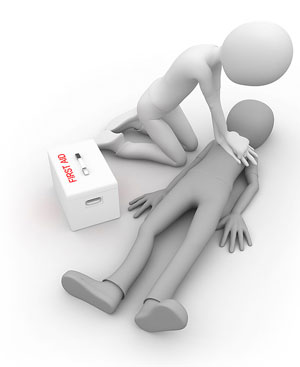
Here, we review basic cardiopulmonary resuscitation (CPR), a vital first aid technique and which if done correctly, can literally save lives.
If someone is not breathing properly and the heart has stopped, we use CPR to keep oxygenated blood circulating. This provides the best possible outcome, pending the arrival of emergency medical assistance. Firstly, always call (or have someone call) the emergency telephone number 999 or 112 at the earliest opportunity. Also, check that the victim is not exposed to any immediate further danger.
Assess consciousness – look at the chest and with your ear near their mouth, listen closely for breathing. If necessary, start CPR immediately. Chest compressions are performed at the rate of 100 to 120 compressions per minute. With the heel of your hand near the centre of the casualty’s chest, place one hand on top of the other. Interlock your fingers and keep both arms straight (do not bend at the elbow); press down five to six centimetres. Continue until an ambulance arrives.
Full CPR involves cycles of thirty chest compressions and two full rescue breaths. Check that the casualty’s mouth does not contain any blockages, then extend the neck to open the airway. If the casualty is still not breathing, pinch the nose shut and seal over his or her mouth with yours, exhaling while watching the chest to check that it rises. If not, re-check the airway, extend the neck again and continue.
With two rescuers, this 30:2 ratio is easier. Counting aloud, this action can be coordinated effectively.
If you have not been trained or are worried about mouth-to-mouth contact, barrier protection may be used. If not, it is possible to provide chest compression (or ‘hands only’) CPR, which some organisations judge to be almost as effective.
In the case of children, compress with less force – to approximately one third of the depth of the chest. With babies under the age of one year, we use only two fingers (not the full heel of the hand) to compress.
Finally, a reminder of key safety points to prevent or reduce the risk of CPR becoming necessary. Children should always be supervised near water. On beaches, beware of rough water and waves, undertows or when red flags are flying. Always swim where lifeguards are on duty, follow advice, do not go in the sea after drinking alcohol and never swim alone.